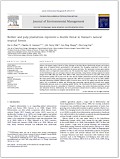| Journal Article |
 |
|
| Article Title | Rubber and pulp plantations represent a double threat to Hainan | | Author | De-Li Zhai, Charles H. Cannon, J.W. Ferry Slik, Cui-Ping Zhang and Zhi-Cong Dai | | Year | 2012 | | Journal Title | Journal of Environmental Management | | Institution | Elsevier Ltd | | Volume | 96 | | Pages | 64-73 | | Call Number | JA0519-14 | | Keywords | Lowland deforestation, Eucalyptus, Hevea, Industrial forest, Protected area, Government policy |
|
| Abstract: |
| Hainan, the largest tropical island in China, belongs to the Indo-Burma biodiversity hotspot and harbors
large areas of tropical forests, particularly in the uplands. The Changhua watershed is the cradle of
Hainan’s main river and a center of endemism for plants and birds. The watershed contains great habitat
diversity and is an important conservation area. We analyzed the impact of rubber and pulp plantations
on the distribution and area of tropical forest in the watershed, using remote sensing analysis of Landsat
images from 1988, 1995 and 2005. From 1988 to 1995, natural forest increased in area (979e1040 sq km)
but decreased rapidly (763 sq km) over the next decade. Rubber plantations increased steadily through
the study period while pulp plantations appeared after 1995 but occupied 152 sq km by 2005. Rubber
and pulp plantations displace different types of natural forest and do not replace one another. Because
pulp is not as profitable as rubber and existing pulp processing capacity greatly exceeds local supply,
considerable pressure exists on remaining upland forests. We recommend for future management that
these plantation forests be reclassified as ‘industrial’, making a clear policy distinction between natural
and industrial forestry. Additionally, the local government should work to enforce existing laws preventing
forest conversion on marginal and protected areas. |
|
|
Download file(s): Click icon to download/open file.
|
| |
File Size |
Description |

|
962 KB |
Softcopy |
|
|
|
| Viewed in 1316 times. Downloaded in 510 times. |